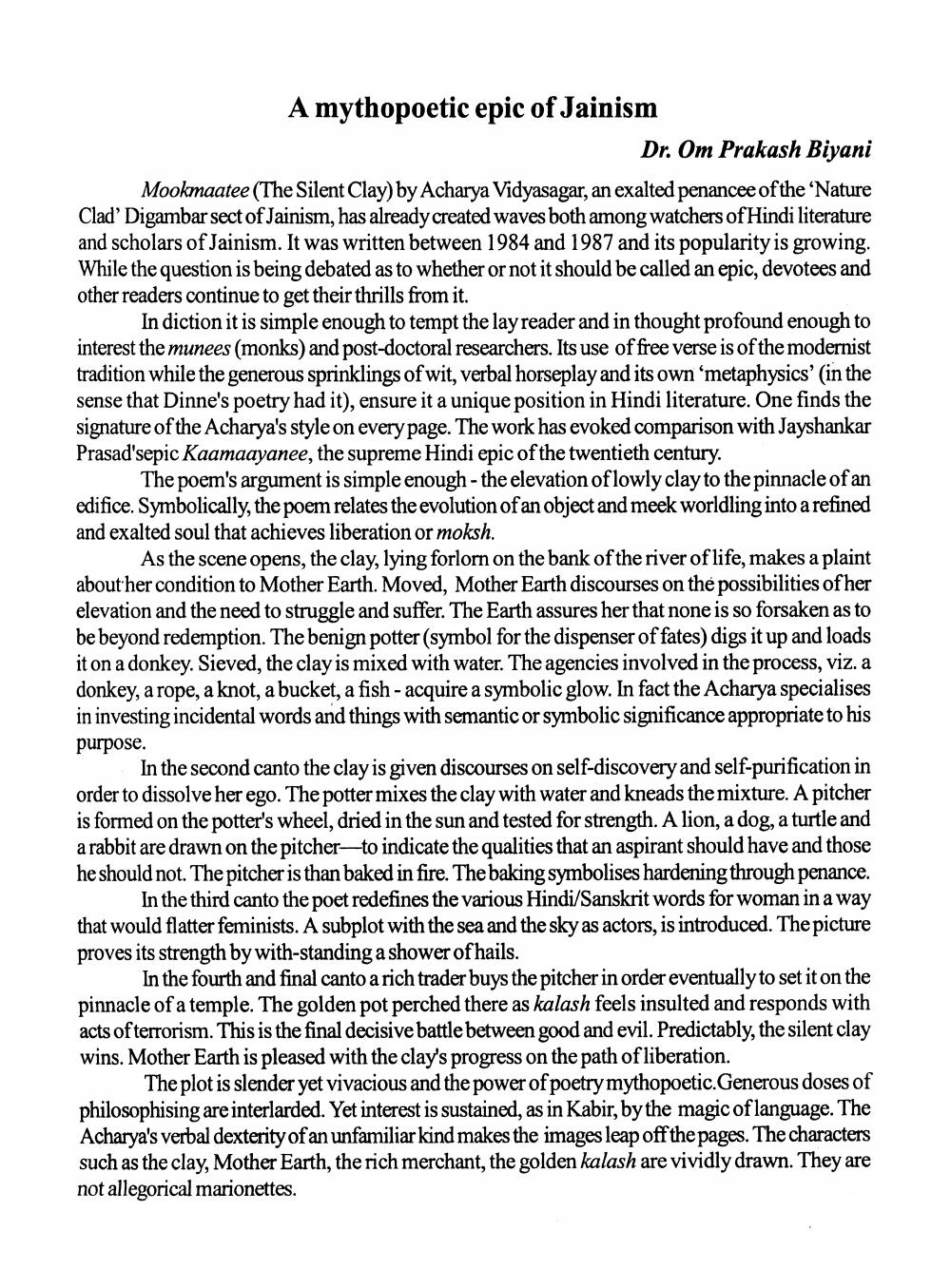________________
A mythopoetic epic of Jainism
Dr. Om Prakash Biyani
Ind:
Mookmaatee (The Silent Clay) by Acharya Vidyasagar, an exalted penancee of the Nature Clad' Digambar sect of Jainism, has already created waves both among watchers of Hindi literature and scholars of Jainism. It was written between 1984 and 1987 and its popularity is growing. While the question is being debated as to whether or not it should be called an epic, devotees and other readers continue to get their thrills from it.
In diction it is simple enough to tempt the lay reader and in thought profound enough to interest the munees (monks) and post-doctoral researchers. Its use of free verse is of the modernist tradition while the generous sprinklings of wit, verbal horseplay and its own ‘metaphysics' in the sense that Dinne's poetry had it), ensure it a unique position in Hindi literature. One finds the signature of the Acharya's style on every page. The work has evoked comparison with Jayshankar Prasad'sepic Kaamaayanee, the supreme Hindi epic of the twentieth century.
The poem's argument is simple enough - the elevation of lowly clay to the pinnacle of an edifice. Symbolically, the poem relates the evolution of an object and meek worldling into a refined and exalted soul that achieves liberation or moksh.
As the scene opens, the clay, lying forlorn on the bank of the river of life, makes a plaint about her condition to Mother Earth. Moved, Mother Earth discourses on the possibilities of her elevation and the need to struggle and suffer. The Earth assures her that none is so forsaken as to be beyond redemption. The benign potter (symbol for the dispenser of fates) digs it up and loads it on a donkey. Sieved, the clay is mixed with water. The agencies involved in the process, viz. a donkey, a rope, a knot, a bucket, a fish - acquire a symbolic glow. In fact the Acharya specialises in investing incidental words and things with semantic or symbolic significance appropriate to his purpose.
In the second canto the clay is given discourses on self-discovery and self-purification in order to dissolve her ego. The potter mixes the clay with water and kneads the mixture. A pitcher is formed on the potter's wheel, dried in the sun and tested for strength. A lion, a dog, a turtle and a rabbit are drawn on the pitcher—to indicate the qualities that an aspirant should have and those he should not. The pitcher is than baked in fire. The baking symbolises hardening through penance.
In the third canto the poet redefines the various Hindi/Sanskrit words for woman in a way that would flatter feminists. A subplot with the sea and the sky as actors, is introduced. The picture proves its strength by with-standing a shower of hails.
In the fourth and final canto a rich trader buys the pitcher in order eventually to set it on the pinnacle of a temple. The golden pot perched there as kalash feels insulted and responds with acts of terrorism. This is the final decisive battle between good and evil. Predictably, the silent clay wins. Mother Earth is pleased with the clay's progress on the path of liberation.
The plot is slender yet vivacious and the power of poetry mythopoetic. Generous doses of philosophising are interlarded. Yet interest is sustained, as in Kabir, by the magic of language. The Acharya's verbal dexterity of an unfamiliar kind makes the images leap off the pages. The characters such as the clay, Mother Earth, the rich merchant, the golden kalash are vividly drawn. They are not allegorical marionettes.
WI,




